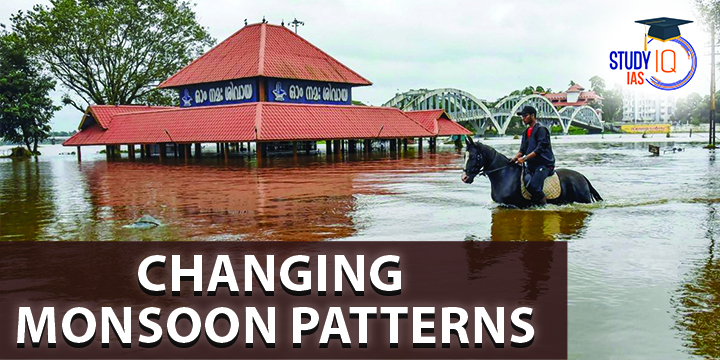Table of Contents
Evidences of Changing Monsoon Patterns
- Changing Monsoon Patterns :The new monsoon normal

- Erratic monsoon: It is observed that there has been a shift in the recent period toward more frequent dry spells and more intense wet spells during the summer monsoon season.
- Delayed monsoon withdrawals:
- In recent years, monsoon withdrawal commencement has been delayed, mostly realising towards either the end of September or early in October. The normal date for the commencement of the withdrawal is September 17.
- According to IMD records for 2012-2022, monsoon withdrawal from northwest India took place in the first half of September only during three years.
Factors Responsible for the Changing Monsoon Patterns in India
- Climate Change
- Warming oceans: The extension of monsoon season can be attributed to warming of the Bay of Bengal and the Arabian Sea. Earlier, rainfall during the monsoon season would bring down the temperature of the ocean. But, because of global warming, the oceans continue to remain warm even after the traditional monsoon season is over. And warmer oceans help the formation of monsoon winds.
- Warming atmosphere: A warmer atmosphere has a greater capacity to hold water. When this water is finally released, it often results in a heavier downpour than would be expected otherwise.
- Atmospheric teleconnections: Due to rising temperatures, there has been an increase in the occurrence of atmospheric teleconnections such as ENSO, Indian Ocean Dipole (IOD) and Madden-Julian Oscillation (MJO), which are directly impacting the monsoonal circulations.
- El Niño–Southern Oscillation (ENSO) is an irregular periodic variation in winds and sea surface temperatures over the tropical eastern Pacific Ocean, affecting the climate of much of the tropics and subtropics. The warming phase of the sea temperature is known as El Niño and the cooling phase as La Niña.
- El Nino leads to a weaker monsoon whereas La Nina favours Indian monsoon.
- The Indian Ocean Dipole (IOD), also known as the Indian Niño, is an irregular oscillation of sea surface temperatures in which the western Indian Ocean becomes alternately warmer (positive phase) and then colder (negative phase) than the eastern part of the ocean.
- During the period of positive IOD, the Indian summer monsoon rainfall is considerably good as compared to the negative IOD period.
- Madden-Julian Oscillation (MJO) is an eastward moving disturbance of clouds, rainfall, winds, and pressure that traverses the planet in the tropics and returns to its initial starting point in 30 to 60 days, on average.
- The impact of MJO on Indian monsoon depends on its periodicity. Shorter the cycle of MJO, better the Indian Monsoon.
- If it is nearly 30 days then it brings good rainfall during the monsoon season.
- If it is above 40 days then MJO doesn’t give good showers and could even lead to a dry monsoon.
- El Niño–Southern Oscillation (ENSO) is an irregular periodic variation in winds and sea surface temperatures over the tropical eastern Pacific Ocean, affecting the climate of much of the tropics and subtropics. The warming phase of the sea temperature is known as El Niño and the cooling phase as La Niña.
What is the Changing Monsoon Patterns
- Monsoon withdrawal begins with the cessation of rainfall activity over northwest India for five straight days, an anticyclone establishing itself in the lower troposphere and a marked reduction in moisture content.
- Withdrawal starts from the last State where monsoon reaches, which is Rajasthan.
- Withdrawal season continues from mid-September to almost end of October. It is then replaced by the retreating, or northeast monsoon in November.


 Daily Quiz 03 July 2025
Daily Quiz 03 July 2025
 Dalai Lama Confirms He will have a Succe...
Dalai Lama Confirms He will have a Succe...
 List of Awards and Honours Received by N...
List of Awards and Honours Received by N...





















